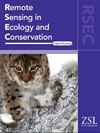Bridging the gap in deep seafloor management: Ultra fine‐scale ecological habitat characterization of large seascapes
IF 4.3
2区 环境科学与生态学
Q1 ECOLOGY
引用次数: 0
Abstract
The United Nations' sustainable development goal to designate 30% of the oceans as marine protected areas by 2030 requires practical management tools, and in turn ecologically meaningful mapping of the seafloor. Particularly challenging is the mesophotic zone, a critical component of the marine system, a biodiversity hotspot, and a potential refuge. Here, we introduce a novel seafloor habitat management workflow, integrating cm‐scale synthetic aperture sonar (SAS) and multibeam bathymetry surveying with efficient ecotope characterization. In merely 6 h, we mapped ~5 km弥合深海底管理的差距:大海景的超细尺度生态栖息地特征
联合国的可持续发展目标是到2030年将30%的海洋指定为海洋保护区,这需要切实可行的管理工具,并相应地绘制具有生态意义的海底地图。尤其具有挑战性的是中鳍区,它是海洋系统的关键组成部分,是生物多样性的热点,也是潜在的避难所。本文介绍了一种新的海底生境管理工作流程,该流程将厘米尺度合成孔径声呐(SAS)和多波束测深测量相结合,并具有高效的生态环境表征。在短短6小时内,我们以亚米分辨率绘制了约5平方公里的复杂中叶藻礁。在SAS图像上应用深度学习分类器,我们以84%的准确率对四个栖息地进行了分类,并定义了相关的细尺度交错带。利用SAS图像导航引导的精确原位采样的视觉普查,对测绘单元进行生态表征。我们的初步鱼类调查表明,高度复杂的地区和岩石/沙子过渡带的生态重要性。如果在没有事先考虑的情况下对该地区进行调查,这些较少的栖息地将在很大程度上被低估。因此,我们的方法被证明可以生成与相关生物区系相关的分辨率的可扩展栖息地地图,这些地图以前无法在中微藻中获得,从而推进了大型海景的生态建模和管理。
本文章由计算机程序翻译,如有差异,请以英文原文为准。
求助全文
约1分钟内获得全文
求助全文
来源期刊

Remote Sensing in Ecology and Conservation
Earth and Planetary Sciences-Computers in Earth Sciences
CiteScore
9.80
自引率
5.50%
发文量
69
审稿时长
18 weeks
期刊介绍:
emote Sensing in Ecology and Conservation provides a forum for rapid, peer-reviewed publication of novel, multidisciplinary research at the interface between remote sensing science and ecology and conservation. The journal prioritizes findings that advance the scientific basis of ecology and conservation, promoting the development of remote-sensing based methods relevant to the management of land use and biological systems at all levels, from populations and species to ecosystems and biomes. The journal defines remote sensing in its broadest sense, including data acquisition by hand-held and fixed ground-based sensors, such as camera traps and acoustic recorders, and sensors on airplanes and satellites. The intended journal’s audience includes ecologists, conservation scientists, policy makers, managers of terrestrial and aquatic systems, remote sensing scientists, and students.
Remote Sensing in Ecology and Conservation is a fully open access journal from Wiley and the Zoological Society of London. Remote sensing has enormous potential as to provide information on the state of, and pressures on, biological diversity and ecosystem services, at multiple spatial and temporal scales. This new publication provides a forum for multidisciplinary research in remote sensing science, ecological research and conservation science.
 求助内容:
求助内容: 应助结果提醒方式:
应助结果提醒方式:


